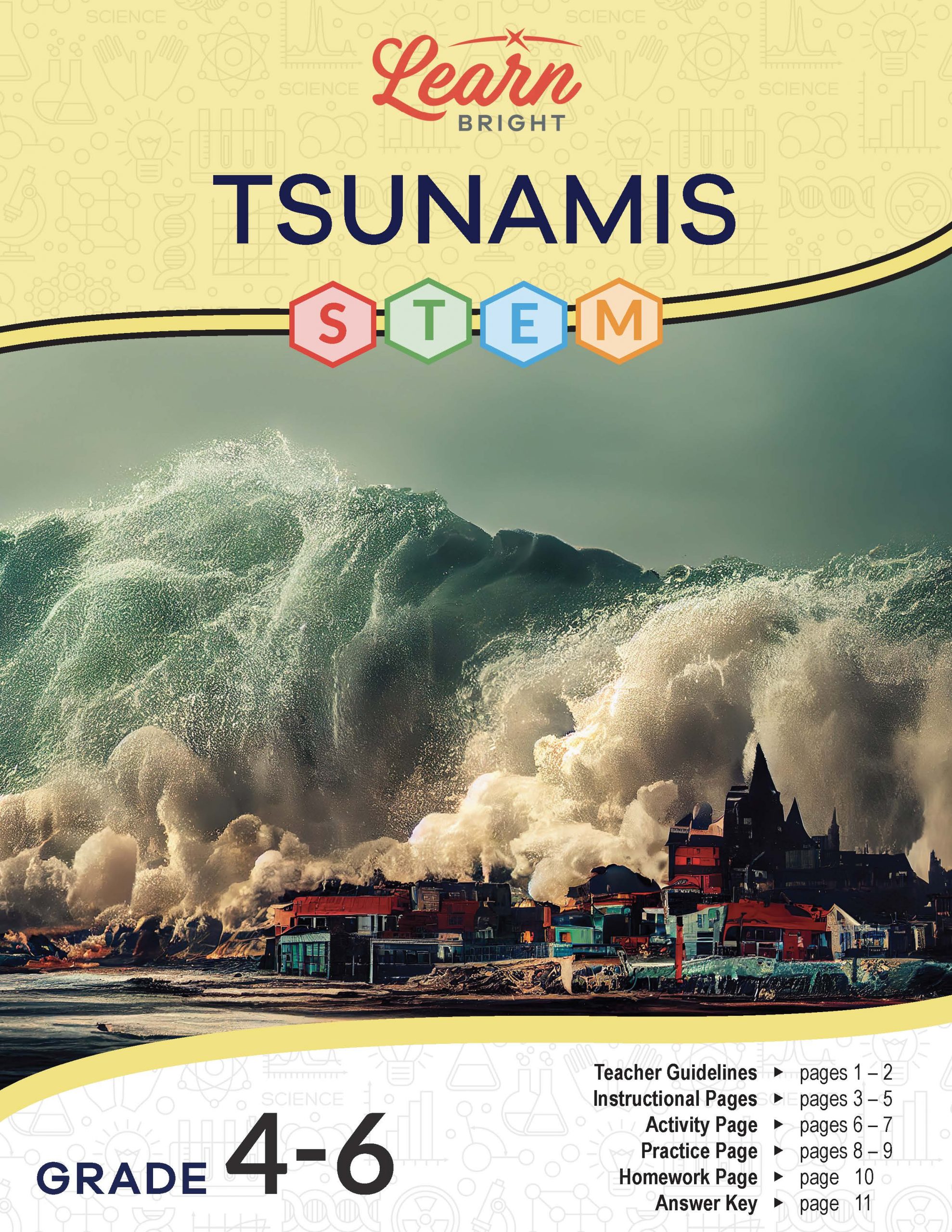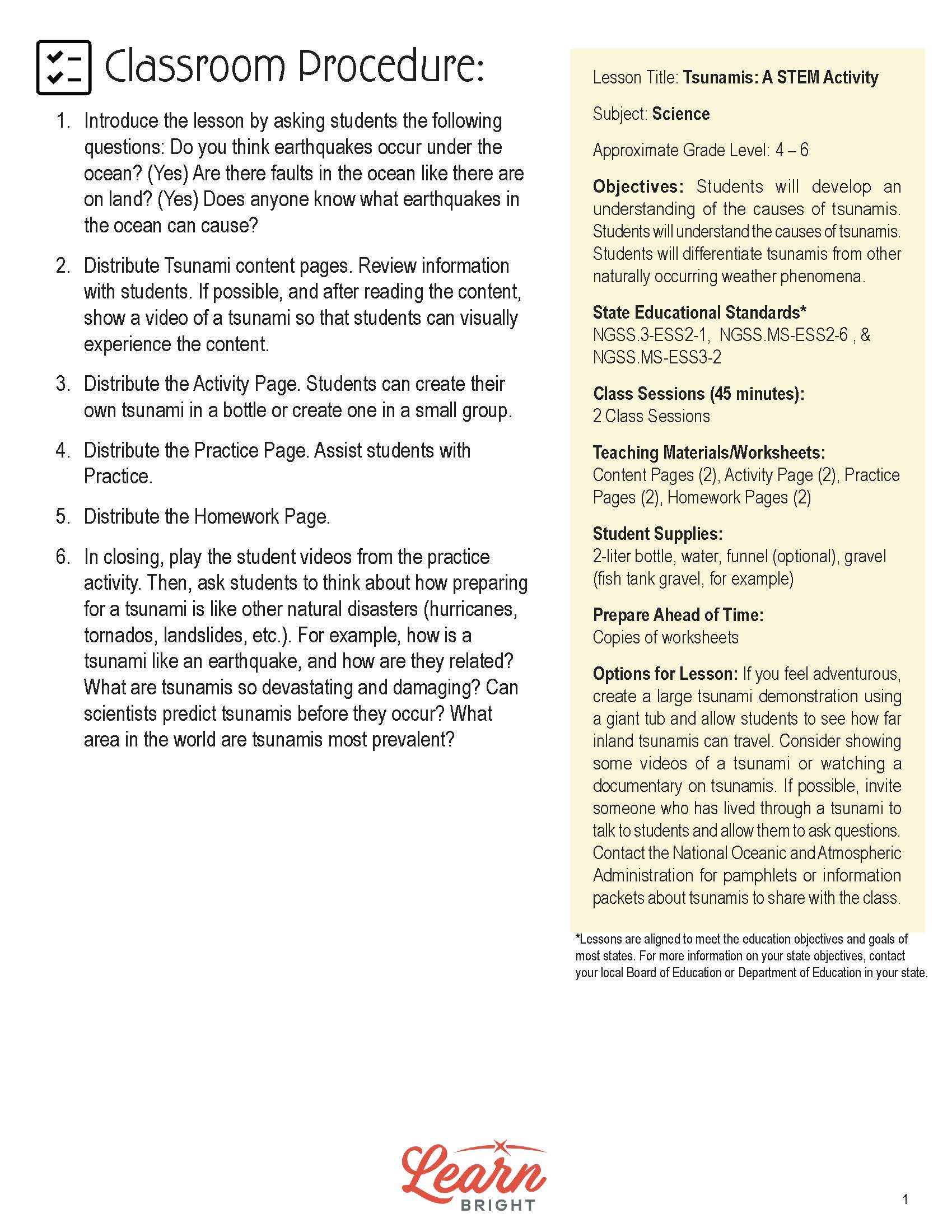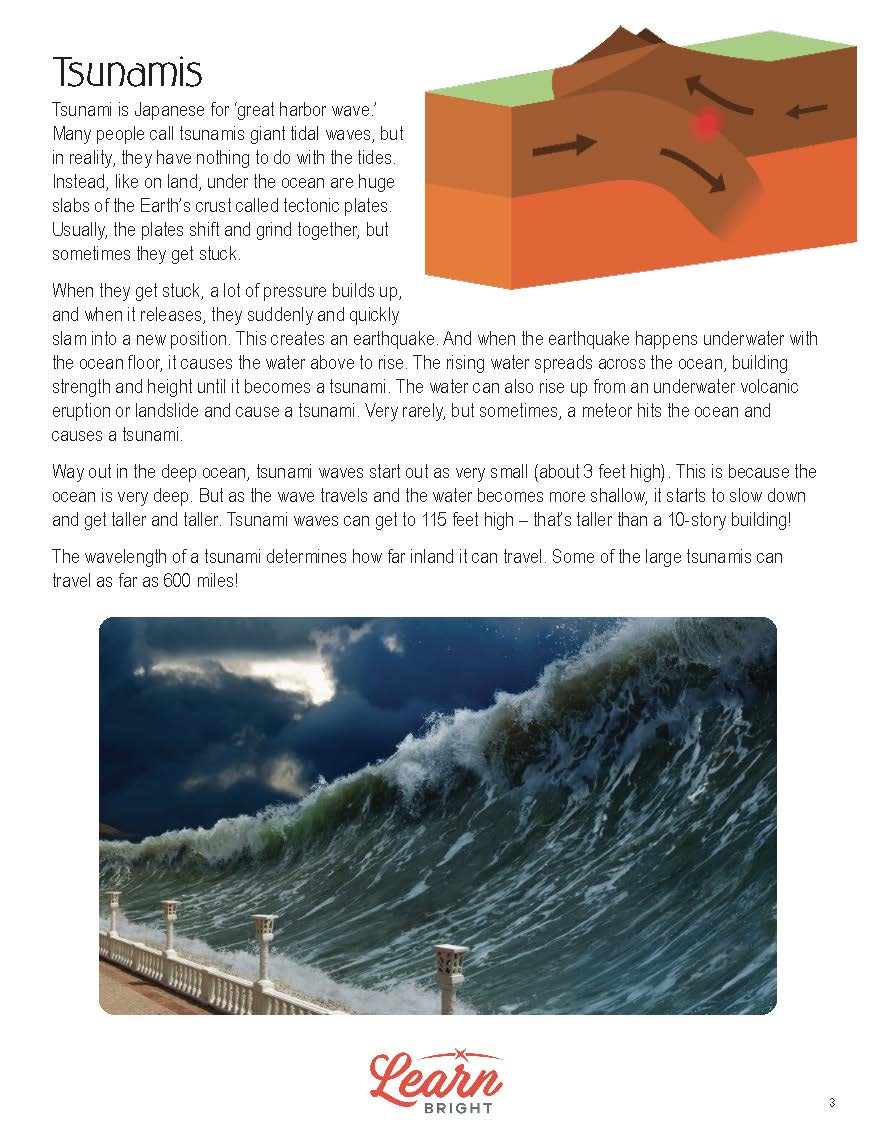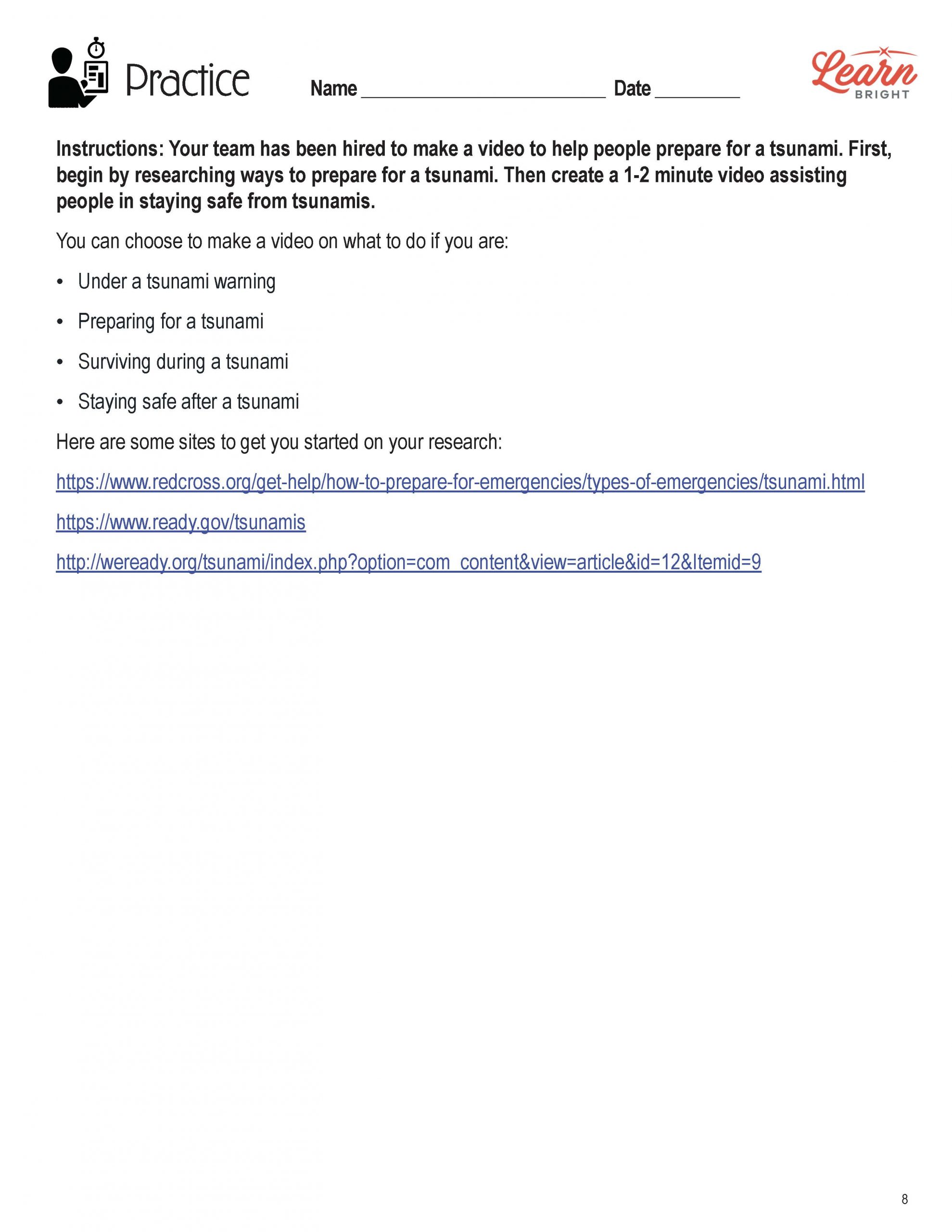Description
What our Tsunamis STEM lesson plan includes
Lesson Objectives and Overview: Tsunamis STEM teaches students about the causes and effects of these natural disasters. Students will learn to differentiate between a tsunami and other naturally occurring weather phenomena. This lesson is for students in 4th grade, 5th grade, and 6th grade.
Classroom Procedure
Every lesson plan provides you with a classroom procedure page that outlines a step-by-step guide to follow. You do not have to follow the guide exactly. The guide helps you organize the lesson and details when to hand out worksheets. It also lists information in the yellow box that you might find useful. You will find the lesson objectives, state standards, and number of class sessions the lesson should take to complete in this area. In addition, it describes the supplies you will need as well as what and how you need to prepare beforehand. For this lesson, you will need 2-liter bottles, water, funnels, and gravel (such as fish tank gravel).
Options for Lesson
There are suggestions in the “Options for Lesson” section of the classroom procedure page for additional activities or ideas. One idea, if you feel adventurous, is to create a large tsunami demonstration using a giant tub and allow students to see how far inland tsunamis can travel. You could also consider showing some videos of a tsunami or watching a documentary on them. If possible, another option is to invite someone who has lived through a tsunami to talk to students and allow them to ask questions. One more idea is to contact the National Oceanic and Atmospheric Administration for pamphlets or information packets about tsunamis to share with the class.
Teacher Notes
The paragraph on this page gives you a little more information on the lesson overall and describes what you may want to focus your teaching on. It could benefit you to teach other lessons on natural disasters and storms in conjunction with Tsunamis STEM. The blank lines are available for you to write out any thoughts or ideas you have as you prepare.
TSUNAMIS STEM LESSON PLAN CONTENT PAGES
Great Harbor Waves
The Tsunamis STEM lesson plan contains three content pages. Students will first learn that tsunami is Japanese for great harbor wave. Many people call tsunamis great tidal waves, but these natural disasters don’t actually have anything to do with the tides. Like on land, tectonic plates—huge slabs of the earth’s crust—exist under the ocean. Usually, the plates shift and grind together. However, they get stuck sometimes.
When tectonic plates beneath the ocean get stuck, a lot pressure builds up. And when that pressure releases, they suddenly and quickly slam into a new position. The result is an underwater earthquake that causes the water above it to rise and spread across the ocean. As the water spreads, its strength and height build up until it becomes a tsunami.
Another way a tsunami forms is from eruptions by underwater volcanoes or landslides. And very rarely, but possible, a meteor can hit the ocean and cause a tsunami too. Tsunami waves start out very small, only about three feet high. But as the wave travels and the water depth becomes more shallow, the wave slows down and gets taller and taller.
The height of a tsunami wave can reach 115 feet, which taller than a 10-story building! The length of a tsunami wave determines how far inland it can travel. Some of the large tsunamis can travel as far as 600 miles!
Where Tsunamis Form
To recap, the lesson provides a diagram to explain how a tsunami forms. Rapid movement of the ocean floor displaces a column of water. A series of waves travel outward and fairly low heights of around three feet. As a wave approaches shallow water and land, its energy compresses into a smaller space, forcing it to gain height.
While tsunamis can happen in any major body of water, the likelihood is highest in the Pacific Ocean. This is because the Pacific Ocean is home to a lot of underwater earthquakes and volcanoes, as well as the Ring of Fire. The Ring of Fire is a series of deep ocean trenches. About 70–80% of tsunamis start in the Ring of Fire! Countries with long coastlines on the Pacific Ocean are at risk of experiencing tsunamis, such as Japan, Chile, and the United States.
As these giant waves come in and go out, they can kill or injure a lot of people and damage or destroy roads and infrastructure. Because of this people have tried to come up with ways to stop tsunamis. For instance, they’ve tried building giant walls to shield them from the wave. The barrier helps reduce the wave’s power, but sometimes the waves are so high that they go right over the wall.
Tsunami Alerts
To help save people’s lives, scientists developed the Pacific Tsunami Warning System (PTWS). This system, based in Hawai’i, consists of a network of detectors that track underwater quakes. In addition, other communities have their own warning systems. The Emergency Alert System (EAS) and the National Oceanic and Atmospheric Administration (NOAA) Weather Radio provide emergency alerts to many communities in the United States.
The lesson provides a chart that shows the different levels of a tsunami alert. At the base is an information statement. This implies that there is no threat or the event is very distant and a threat has not yet been determined. In these cases, people can simply relax. Watch level is next and implies that a distant tsunami is possible. People should stay tuned for information and be prepared to act.
An advisory alert suggests strong currents and waves are possible that are dangerous to those in or very near water. People should stay out of the water and away from beaches and waterways. Finally, highest alert is a warning that dangerous coastal flooding and powerful currents are possible. In a case like this, people should move to high ground or inland.
TSUNAMIS STEM LESSON PLAN WORKSHEETS
The Tsunamis STEM lesson plan includes three worksheets: an activity worksheet, a practice worksheet, and a homework assignment. Each one will help students solidify their grasp of the material they learned throughout the lesson. You can refer to the classroom procedure guidelines to know when to hand out each worksheet.
CREATE A TSUNAMI ACTIVITY WORKSHEET
Students will get to create their own tsunami for the activity. First, they will fill a two-liter bottle with about 2–3 inches of gravel. They will pour in a cup of water and screw the cap on very tight. Then they will slowly lower the bottle to its side, slowly enough that a slope forms at the end of the bottle.
Next, students will draw a picture of what the bottle looks like. The worksheet lists a couple prompts for them to respond to before they continue. Once they answer the questions, they will use the palm of their hand to smack the side of the bottle that doesn’t have gravel to create a wave and observe what happens. Then they will respond to the last prompt about their observations.
VIDEO AD PRACTICE WORKSHEET
For the practice worksheet, students will create a video that would help people prepare for a tsunami. They will first need to research ways to prepare for this type of disaster. Then they can create a video that is one to two minutes long that describes how to stay safe from a tsunami. The worksheet provides a short list of more specific topics that they could focus their video on. It also lists a few sites that will help students get started on their research.
TSUNAMIS STEM HOMEWORK ASSIGNMENT
The homework assignment requires students to read a list of 50 facts about tsunamis from a specific website. Students will choose seven facts that they find the most interesting to them. In the space provided on the page, they will describe why that fact is interesting. (If, for whatever reason, the website is inaccessible, students can instead just research facts to fill in the list.)
Worksheet Answer Keys
The lesson plan includes answer keys for all three worksheets. Given the nature of some of the questions or prompts, there may be some variation in students’ responses. The homework assignment provides a sample answer, for instance, but does not fill in the whole table. Correct answers are in red to make it easy to compare them to your students’ work. If you choose to administer the lesson pages to your students via PDF, you will need to save a new file that omits these pages. Otherwise, you can simply print out the applicable pages and keep these as reference for yourself when grading assignments.









